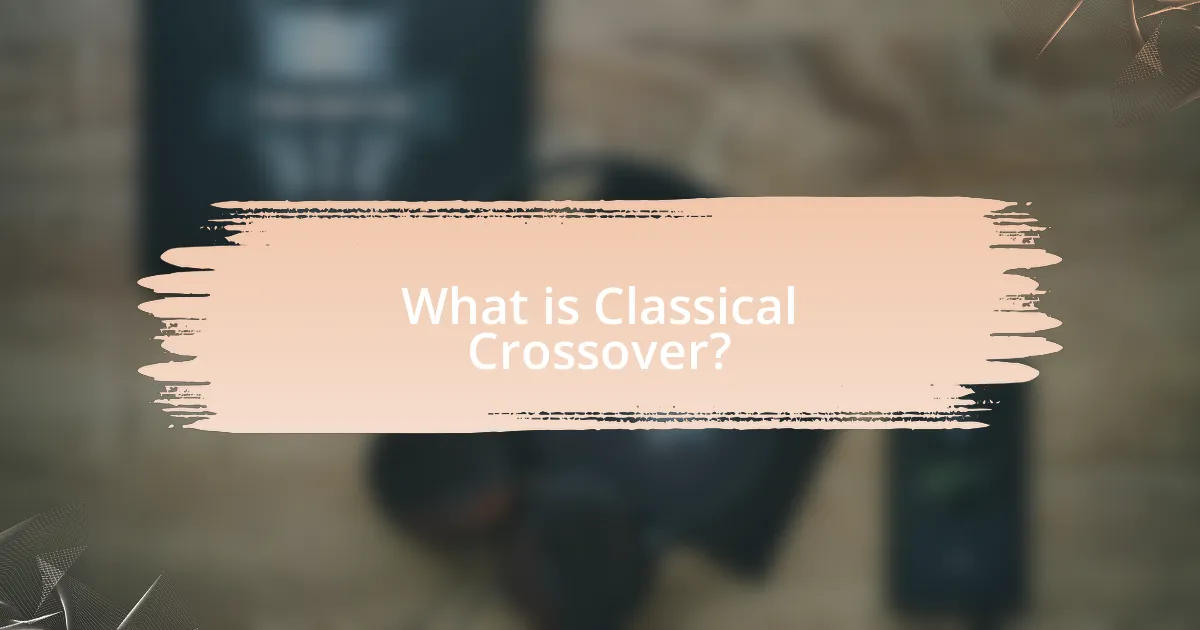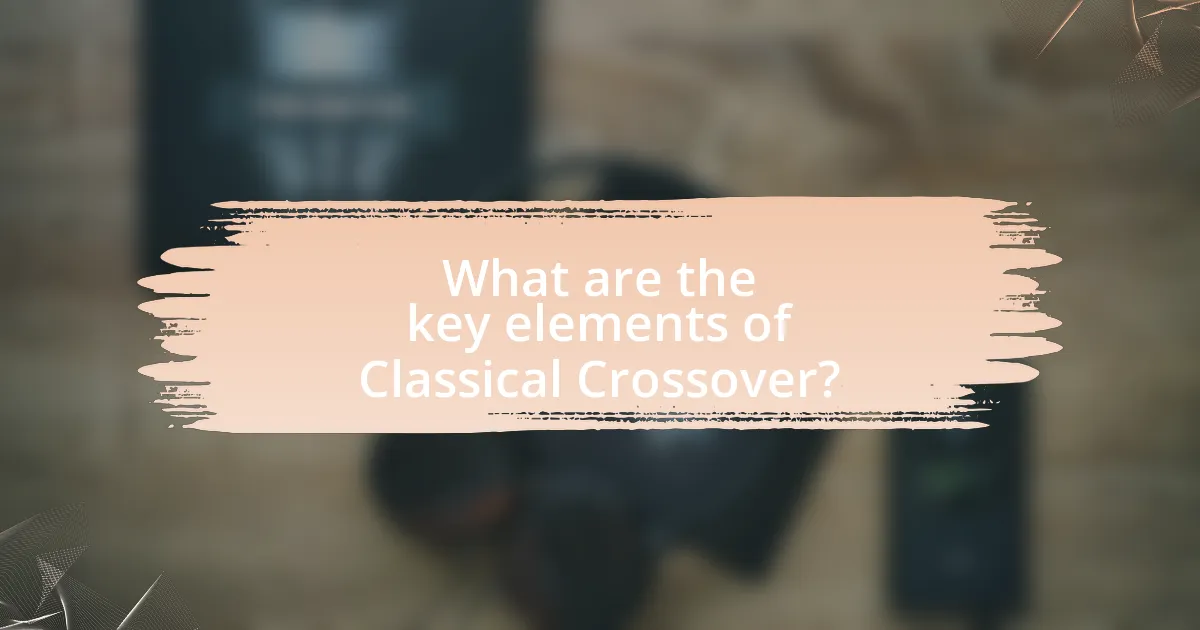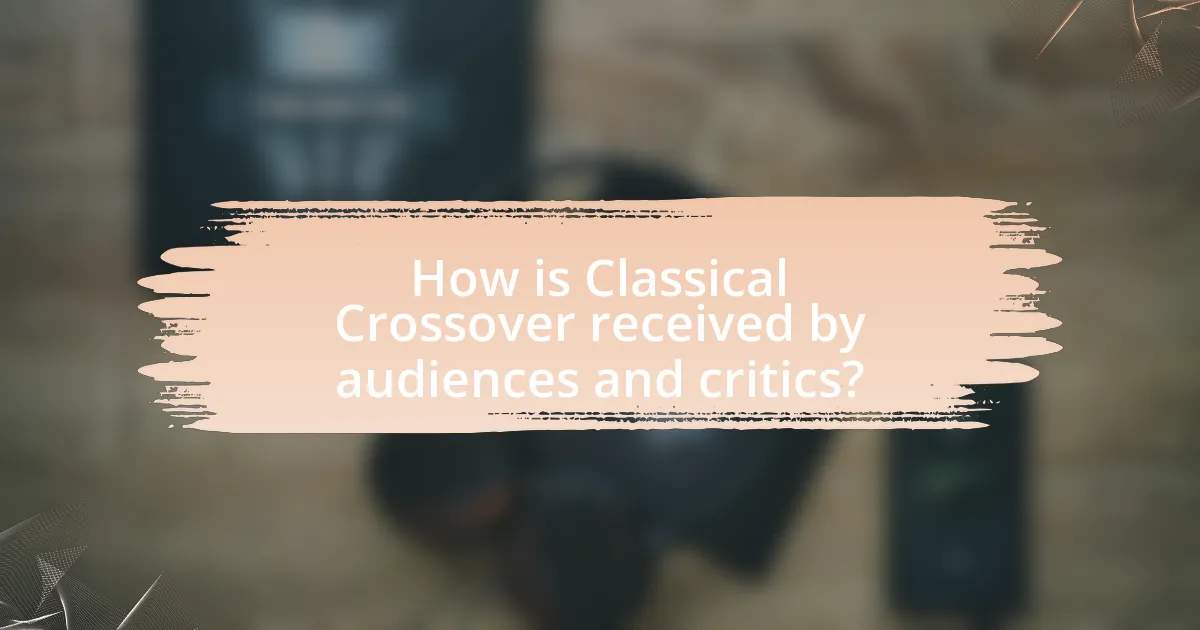Classical crossover is a musical genre that merges classical music elements with popular styles, appealing to a diverse audience. This article explores the defining characteristics of classical crossover, its evolution, and its appeal to new listeners, highlighting key artists such as Andrea Bocelli and Il Divo. It examines how this genre bridges the gap between classical and contemporary music, the demographic trends influencing its popularity, and the critical responses it receives. Additionally, the article discusses the impact of classical crossover on the music industry, including sales trends and the adaptation of record labels to this phenomenon.

What is Classical Crossover?
Classical crossover is a musical genre that blends elements of classical music with popular music styles, creating a hybrid that appeals to a broader audience. This genre often features classical instrumentation and vocal techniques while incorporating contemporary genres such as pop, rock, and jazz. Notable examples include artists like Andrea Bocelli and Il Divo, who have successfully merged operatic vocals with mainstream appeal, demonstrating the genre’s ability to attract listeners from both classical and popular music backgrounds.
How does Classical Crossover differ from traditional genres?
Classical Crossover differs from traditional genres by integrating elements of classical music with popular music styles, creating a hybrid that appeals to a broader audience. This genre often features classical instrumentation and vocal techniques while incorporating contemporary genres such as pop, rock, or jazz, which is not typical in traditional classical music. For example, artists like Andrea Bocelli and Il Divo have successfully blended operatic vocals with pop melodies, attracting listeners who may not typically engage with classical music. This fusion allows Classical Crossover to reach diverse demographics, expanding its audience beyond the confines of traditional classical music.
What are the defining characteristics of Classical Crossover?
Classical Crossover is characterized by the fusion of classical music elements with popular music genres, creating a hybrid sound that appeals to a broader audience. This genre often features orchestral arrangements combined with contemporary vocals or instrumentation, allowing for a diverse range of musical expressions. Notable examples include artists like Andrea Bocelli and Il Divo, who blend operatic techniques with pop sensibilities, demonstrating the genre’s ability to attract listeners from both classical and mainstream music backgrounds. The success of Classical Crossover can be evidenced by its commercial viability, with albums frequently topping charts and reaching audiences beyond traditional classical music fans.
How has Classical Crossover evolved over time?
Classical Crossover has evolved significantly since its emergence in the late 20th century, transitioning from niche performances to mainstream popularity. Initially, artists like Andrea Bocelli and Sarah Brightman began blending classical music with pop elements, attracting a broader audience and paving the way for the genre’s growth. By the early 2000s, the genre gained further traction with the rise of groups such as Il Divo and the Three Tenors, who combined operatic vocals with contemporary arrangements, leading to increased commercial success and chart presence. This evolution continued with the incorporation of diverse musical styles, including rock and electronic influences, as seen in the works of artists like 2Cellos and Lindsey Stirling. The genre’s adaptability and appeal to younger audiences have solidified its place in the music industry, evidenced by the proliferation of crossover albums and collaborations across various genres.
Why is Classical Crossover appealing to a new audience?
Classical Crossover is appealing to a new audience because it merges classical music with contemporary genres, making it more accessible and relatable. This genre attracts listeners who may not typically engage with traditional classical music by incorporating popular elements such as pop, rock, and jazz, which resonate with modern tastes. For instance, artists like Andrea Bocelli and Il Divo have successfully reached wider audiences by blending operatic vocals with mainstream music styles, resulting in significant album sales and concert attendance. The fusion of these genres not only broadens the listener base but also revitalizes interest in classical music, as evidenced by the increasing number of crossover concerts and collaborations in recent years.
What demographic trends are influencing the popularity of Classical Crossover?
The popularity of Classical Crossover is influenced by several demographic trends, particularly the increasing diversity of music consumption among younger audiences. Younger generations, especially Millennials and Gen Z, are more open to genre-blending and seek innovative musical experiences that combine classical elements with contemporary styles. This trend is supported by data showing that streaming platforms have significantly increased access to a wide range of musical genres, allowing listeners to discover and enjoy Classical Crossover artists like Andrea Bocelli and Il Divo. Additionally, the rise of social media has facilitated the sharing of Classical Crossover music, further broadening its appeal across various demographic groups.
How does Classical Crossover bridge the gap between classical and contemporary music?
Classical Crossover bridges the gap between classical and contemporary music by integrating elements from both genres, creating a hybrid that appeals to diverse audiences. This genre often features classical instrumentation and vocal techniques while incorporating modern styles, such as pop, rock, or electronic music. For instance, artists like Andrea Bocelli and Il Divo have successfully combined operatic vocals with contemporary arrangements, attracting listeners who may not typically engage with traditional classical music. The fusion of these styles not only broadens the audience base but also revitalizes classical music, making it more accessible and relevant in today’s musical landscape.

What are the key elements of Classical Crossover?
The key elements of Classical Crossover include the fusion of classical music with popular genres, the incorporation of diverse vocal styles, and the use of contemporary arrangements. This genre blends orchestral instrumentation with elements from pop, rock, and jazz, creating a sound that appeals to a broader audience. Notable examples include artists like Andrea Bocelli and Il Divo, who have successfully merged operatic techniques with mainstream music, demonstrating the genre’s versatility and commercial viability. The rise of Classical Crossover has been supported by significant sales figures, with albums often topping charts across multiple genres, indicating its widespread acceptance and popularity.
What genres are commonly blended in Classical Crossover?
Classical Crossover commonly blends genres such as classical music, pop, rock, and jazz. This fusion allows artists to reach a broader audience by combining the technical sophistication of classical music with the accessibility of contemporary styles. For instance, artists like Andrea Bocelli and Il Divo exemplify this blend by incorporating operatic elements into popular music formats, thereby creating a unique sound that appeals to fans of both genres.
How do these genres complement each other in Classical Crossover?
Classical crossover genres complement each other by merging the technical precision of classical music with the emotional accessibility of popular genres. This fusion allows artists to reach a broader audience, as evidenced by the success of performers like Andrea Bocelli and Il Divo, who have sold millions of albums by blending operatic vocals with pop melodies. The combination enhances the listening experience, making classical elements more relatable and engaging for contemporary listeners, thereby expanding the appeal of classical music beyond traditional boundaries.
What are some notable examples of genre combinations in Classical Crossover?
Notable examples of genre combinations in Classical Crossover include the blending of classical music with pop, rock, and electronic genres. For instance, Andrea Bocelli’s collaborations with pop artists like Sarah Brightman in “Time to Say Goodbye” showcase the fusion of operatic vocals with contemporary pop elements. Additionally, the group 2Cellos combines classical cello techniques with rock music, performing covers of songs by artists like Michael Jackson and AC/DC. Furthermore, the project “Classic FM’s Hall of Fame” highlights various artists who merge classical compositions with modern genres, illustrating the broad appeal of Classical Crossover. These examples demonstrate how Classical Crossover effectively reaches diverse audiences by integrating different musical styles.
What role do artists play in the Classical Crossover movement?
Artists play a crucial role in the Classical Crossover movement by bridging the gap between classical music and popular genres, thereby expanding the audience for both. They reinterpret classical compositions through contemporary styles, making the music more accessible and appealing to a broader demographic. For instance, artists like Andrea Bocelli and Il Divo have successfully integrated operatic elements with pop music, resulting in commercially successful albums that have sold millions worldwide. This blending not only revitalizes classical music but also introduces new listeners to its richness, demonstrating the significant impact artists have in shaping and popularizing the Classical Crossover genre.
Who are the leading artists in the Classical Crossover genre?
The leading artists in the Classical Crossover genre include Andrea Bocelli, Il Divo, and Sarah Brightman. Andrea Bocelli is renowned for his powerful tenor voice and has sold over 90 million records worldwide, making him one of the best-selling music artists. Il Divo, a vocal group formed in 2003, has achieved significant commercial success with their blend of operatic pop, selling over 30 million albums globally. Sarah Brightman, known for her role in “The Phantom of the Opera,” has also made a substantial impact in the genre, with over 30 million records sold and a unique style that combines classical and contemporary music elements. These artists exemplify the fusion of classical music with popular genres, attracting a diverse audience.
How do these artists influence the perception of Classical Crossover?
Artists in the Classical Crossover genre significantly influence its perception by merging classical music elements with contemporary styles, thereby broadening its appeal. For instance, artists like Andrea Bocelli and Il Divo have introduced operatic vocals to pop music, attracting listeners who may not typically engage with classical genres. This blending not only revitalizes classical music but also challenges traditional boundaries, making it more accessible to a diverse audience. The success of crossover albums, such as Bocelli’s “Romanza,” which sold over 20 million copies worldwide, exemplifies how these artists reshape public perception and expand the listener base for classical music.

How is Classical Crossover received by audiences and critics?
Classical Crossover is generally well-received by audiences and critics, often praised for its innovative blend of classical music with contemporary genres. Audiences appreciate the accessibility and emotional resonance of the music, which attracts a diverse listener base, including those who may not typically engage with classical music. Critics frequently highlight the genre’s ability to bridge cultural gaps and introduce classical elements to a wider audience, as seen in the success of artists like Andrea Bocelli and Il Divo, who have achieved significant commercial success and critical acclaim. This positive reception is supported by sales figures, such as the genre’s consistent presence on popular music charts and its ability to sell out large venues, indicating a strong demand and appreciation from both fans and critics alike.
What are the critical responses to Classical Crossover music?
Critical responses to Classical Crossover music often highlight its blending of classical and popular genres, which can elicit both praise and criticism. Critics argue that this genre dilutes the integrity of classical music by prioritizing commercial appeal over artistic authenticity. For instance, musicologist Joseph Kerman has expressed concerns that Classical Crossover may lead to a superficial understanding of classical traditions. Conversely, proponents argue that it democratizes classical music, making it more accessible to broader audiences, as evidenced by the commercial success of artists like Andrea Bocelli and Il Divo, who have introduced classical elements to mainstream listeners. This duality in responses reflects ongoing debates about the value and impact of genre fusion in contemporary music.
How do critics evaluate the artistic merit of Classical Crossover?
Critics evaluate the artistic merit of Classical Crossover by analyzing its fusion of classical music elements with contemporary genres, assessing both technical proficiency and emotional impact. They often consider the arrangement quality, vocal performance, and instrumental execution, comparing these aspects to traditional classical standards. For instance, critics may reference the success of artists like Andrea Bocelli and Il Divo, who have achieved commercial success while maintaining a level of classical integrity, thus demonstrating that Classical Crossover can appeal to both classical purists and mainstream audiences. This dual appeal is often cited as a key factor in its artistic evaluation, as it reflects the genre’s ability to innovate while respecting its roots.
What are common misconceptions about Classical Crossover?
Common misconceptions about Classical Crossover include the belief that it lacks authenticity and is merely a commercialized genre. Critics often argue that blending classical music with popular styles dilutes the integrity of classical compositions. However, Classical Crossover artists like Andrea Bocelli and Il Divo have demonstrated that this genre can introduce classical elements to wider audiences while maintaining artistic quality. Additionally, some people think that Classical Crossover is a recent phenomenon, but its roots can be traced back to the 20th century, with artists like Luciano Pavarotti collaborating with pop musicians, showcasing its long-standing appeal and evolution.
How does Classical Crossover impact the music industry?
Classical crossover significantly impacts the music industry by expanding audience demographics and increasing revenue streams. This genre blends classical music elements with popular music styles, attracting listeners who may not typically engage with traditional classical music. For instance, artists like Andrea Bocelli and Il Divo have achieved commercial success by appealing to both classical and pop audiences, resulting in millions of album sales and sold-out concerts. According to a report by the Recording Industry Association of America (RIAA), classical crossover albums have seen a notable rise in sales, contributing to a diversification of the music market. This genre not only revitalizes interest in classical music but also encourages collaborations between classical musicians and contemporary artists, fostering innovation within the industry.
What trends in music sales and streaming reflect the rise of Classical Crossover?
The rise of Classical Crossover is reflected in increasing music sales and streaming figures, particularly through the growth of genre-blending artists and collaborations. For instance, streaming platforms like Spotify have reported a significant uptick in playlists dedicated to Classical Crossover, with millions of followers, indicating a growing audience interest. Additionally, the Recording Industry Association of America (RIAA) noted that Classical Crossover albums have seen a rise in sales, with artists like Andrea Bocelli and Il Divo achieving multi-platinum status, showcasing the commercial viability of this genre. Furthermore, data from Nielsen Music shows that Classical Crossover tracks are frequently featured in mainstream charts, highlighting their crossover appeal and the expanding listener base that embraces this fusion of classical and contemporary music styles.
How are record labels adapting to the Classical Crossover phenomenon?
Record labels are adapting to the Classical Crossover phenomenon by diversifying their artist rosters and embracing innovative marketing strategies. This shift includes signing artists who blend classical music with popular genres, such as pop and rock, to attract a broader audience. For instance, labels have invested in cross-genre collaborations, exemplified by artists like Andrea Bocelli and Il Divo, who have successfully merged classical elements with mainstream appeal. Additionally, record labels are leveraging digital platforms and social media to promote these artists, utilizing targeted advertising to reach younger demographics that are increasingly interested in genre-blending music. This strategic approach is supported by the growing sales figures in the Classical Crossover genre, which have seen significant increases in streaming and album sales over recent years, indicating a successful adaptation to changing consumer preferences.
What are some best practices for engaging with Classical Crossover?
To effectively engage with Classical Crossover, artists should focus on blending classical elements with contemporary genres to attract a diverse audience. This involves selecting popular songs and reinterpreting them with orchestral arrangements, which has been shown to broaden appeal; for instance, artists like Andrea Bocelli and Il Divo have successfully merged pop and classical styles, resulting in significant commercial success. Additionally, incorporating visual elements such as engaging performances and music videos can enhance audience connection, as seen in the rise of crossover concerts that feature theatrical elements. Collaborating with artists from various genres can also introduce new audiences to Classical Crossover, exemplified by projects like “The Piano Guys,” who combine classical music with modern pop hits.
How can listeners discover new Classical Crossover artists and works?
Listeners can discover new Classical Crossover artists and works through various platforms and resources. Streaming services like Spotify and Apple Music offer curated playlists specifically for Classical Crossover, showcasing emerging artists and their latest releases. Additionally, social media platforms such as Instagram and YouTube allow fans to follow artists directly, providing access to new music and performances. Music blogs and websites dedicated to Classical Crossover often feature reviews and recommendations, helping listeners stay informed about new talent. Furthermore, attending live performances and festivals focused on this genre can introduce audiences to both established and up-and-coming artists.
What tips can enhance the experience of enjoying Classical Crossover music?
To enhance the experience of enjoying Classical Crossover music, listeners should focus on creating an immersive environment. This can be achieved by using high-quality audio equipment, as superior sound systems can significantly improve the clarity and richness of the music. Research indicates that sound quality directly influences listener satisfaction, with studies showing that high-fidelity audio can enhance emotional responses to music. Additionally, engaging with the music visually, such as through live performances or music videos, can deepen the connection to the genre. Engaging with the background of the artists and the compositions can also enrich the experience, as understanding the context and influences behind the music fosters a greater appreciation.